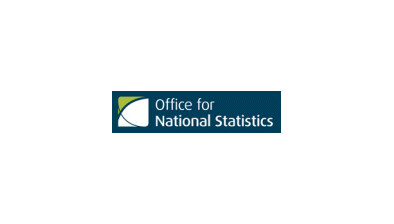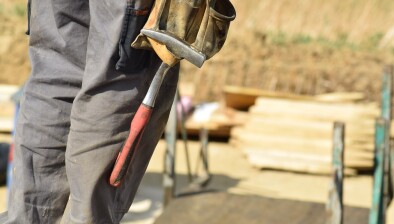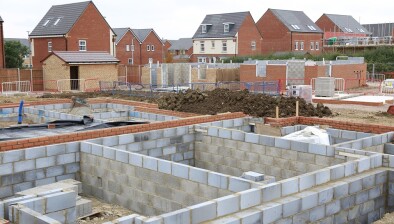Output increase fails to paint over ‘bleak’ picture for construction industry
A 1.3% increase in UK construction output has been welcomed after a slight dip in previous months, but the overall picture remains bleak for the industry as it faces soaring prices with materials and skills shortages continuing to bite.

Latest construction figures from the Office of National Statistics (ONS) found monthly construction output grew 1.3% in volume terms in September 2021 with new work and repair and maintenance both growing on the month, increasing by 1.3% and 1.2% respectively.
The level of construction output in September 2021 was 1.0% (£141 million) below the level of February 2020, before the coronavirus pandemic. New work was 3.5% (£334m) below the February 2020 level, while repair and maintenance work was 3.9% (£194m) above the February 2020 level.
In contrast to the monthly growth, quarterly construction output fell 1.5% in Quarter 3 (July to Sep) 2021, compared with Quarter 2 (Apr to Jun) 2021; both new work (0.3%) and repair and maintenance saw decreases (3.6%).
Total construction new orders fell 9.2% (£1,221m) in Quarter 3 2021, compared with Quarter 2 2021.
The annual rate of construction output price growth was 5.1% in September 2021; this was the strongest annual rate of construction output price growth since records began in 2014. At the type of work level, the annual rate of price growth in the 12 months to September 2021 was at its strongest in new housing (7.5%) and private industrial new work (6.3%).
Brian Berry, chief executive of the Federation of Master Builders, said: “The 1.3% improvement in construction output in September is a positive turnaround from the fall in previous months. The 1.5% drop in overall output for Q3 2021, from Q2, signals the continued need for action to be taken to resolve building material and skills shortages.
“Through the FMB’s State of Trade Survey for Q3, we know that 89% of small, local builders have been forced to press pause on jobs as a result of material and labour shortages, with 97% having experienced increased material costs. The fact that we are now experiencing the strongest annual rate of construction output price growth since records began indicates the unhealthy effects of these two issues on the sector.”
Ian Taylor, partner and real estate expert at RSM, said: “Construction output fell by 1.0% in the month to September and is now 1.0% below the pre-pandemic February 2020 level -delivering a £334m or 3.5% drop in new work since February 2020. However, this fall has stabilised somewhat in the last month. The overall fall in output hides a mixed picture since the start of the pandemic with infrastructure 47.3% above and private commercial 27.0% below their respective February 2020 levels in September 2021.
“Continuing shortages of essential materials and labour are continuing to be the main drivers behind the decline. The pressure on input prices is feeding through to construction output price growth, which was 5.1% in September 2021, the strongest annual rate of construction output price growth on record.
“It was expected that growth in the market would slow after the initial dramatic recovery from the pandemic, but issues in the supply chain and the labour force are now critical and causing input prices to rise at a record rate, resulting in the industry’s growth coming to a halt and reverse.
“This is now the sixth successive monthly fall in construction output caused by the supply chain issues and rising prices. The supply chain disruption is frustrating as order books are healthy, but the availability of materials is having a detrimental effect on projects that are underway. A survey showed that 10% of respondents were unable to source materials, goods or services needed from within the UK in the last month. We can only hope that the bottlenecks in the supply chain can be resolved so that contractors can meet the demand in the marketplace and reverse the trend of falling output.”
Clive Docwra, managing director of property and construction consultancy McBains, said: “September’s return to growth will give the construction industry a degree of encouragement that it may be turning the corner, after five successive falls in monthly output.
“The industry will be cautious however, as output is still below pre-pandemic levels. The Quarter 3 figures also published today also show a fall in output compared to Quarter 2, reflecting the volatility in certain work sectors – a decline in infrastructure and private commercial new orders in particular.
“The quarterly figures also reflect that supply chain problems linked to a shortage of haulage drivers were impacting to a certain extent, but these should be past their peak and are smoothing over. However, the cost of essential materials remains high, and skills shortages are still biting, leading to some new work being put on hold because there just aren’t enough skilled workers available.”
Gareth Belsham, director of the national property consultancy and surveyors Naismiths, said: “The summer boom has burnt itself out. After four straight successive quarters of expansion, the construction industry contracted sharply in Q3.
“The decline earnt construction the economy’s wooden spoon. Manufacturing contracted by a more modest 0.3% and the services sector grew by 1.6% during the third quarter.
“Construction’s lacklustre performance confirms that the chronic shortages of both building materials and people are proving to be serious obstacles to growth.
“With concrete, timber, glass and steel all in short supply, the ONS data reveals that in October, 10% of builders simply could not source the materials they needed. A quarter of contractors managed to get what they needed but were forced to change suppliers.
“This is far higher than the proportion of businesses in other industries reporting similar supply problems, suggesting that construction has been hit harder than most by the perfect storm of staff and material shortages.
“While many firms’ order books remain very healthy after the surge in optimism and new orders seen earlier this year, there’s a definite ‘morning after’ feel to the latest new order numbers.
“The value of new orders being placed slumped by 9.2%, or £1.2bn, between the second and third quarters, as increasing numbers of clients pressed the pause button on their construction plans.
“Nevertheless this latest official data is far from a washout. After falling in August, construction output actually grew in September by £178m, or 1.3%, allowing some to hope the worst may be past.
“Sentiment across the industry remains broadly upbeat, and while soaring inputs costs and supply chain problems are dogging projects of all sizes, the sector has weathered far worse than this in the past.
“After a stellar recovery from the pandemic’s initial impact, construction has fallen back to Earth with a bump and we expect growth to be more measured from here.”
Fraser Johns, finance director at Beard, added: “The growth recorded in September is an encouraging sign. Following a concerning trend of declining output, this will hopefully mark a turning point for the construction industry.
“Recovering from the pandemic was never going to be plain sailing the whole way. Despite the positive signs in September, looking at the quarter as a whole, Q3 marked the first quarterly fall in output since Q2 2020.
“However, it appears client confidence is gradually returning in the market, as new work increased in September. As more clients are giving the green light to projects, it appears supply chain issues and price rises for raw materials will not be an insurmountable challenge.
“By working closely with suppliers, and with clients, lead in times can be built into projects. At Beard, we are well positioned to handle the disruption caused by the supply issues due to the relationships we’ve built with suppliers. These allow us to have open and honest conversations, which ensure if we do run into supply issues, we can work with the supplier and client to overcome these.”















